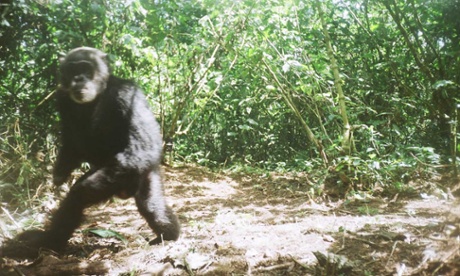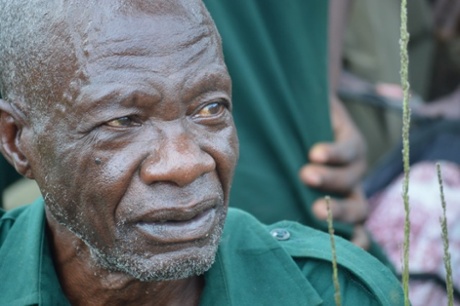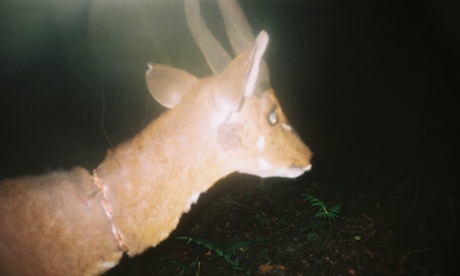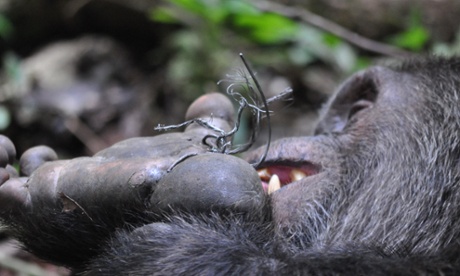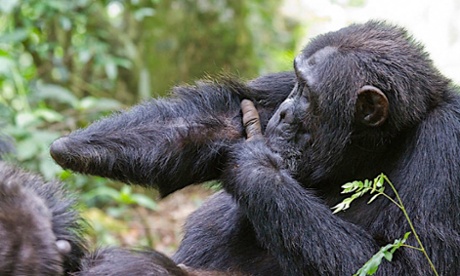
Meet Max: Max is a double amputee, having lost both his right and left legs below the knee. He lost his limbs not to war, disease, or a car accident, but to wire snares. You see, Max is a chimpanzee in Uganda’s Kibale National Park. Before he turned eight, Max was caught by snares twice, losing a part of a leg each time. Despite these handicaps, he is a remarkable survivor, forced to crawl when on the ground but able to climb trees with the best of them. Still, Max, now 15, will never head his troupe or lead a normal chimp life.
Snares are “the landmines of the forest,” according to Jessica Hartel, the director of the Kibale Snare Removal Program.
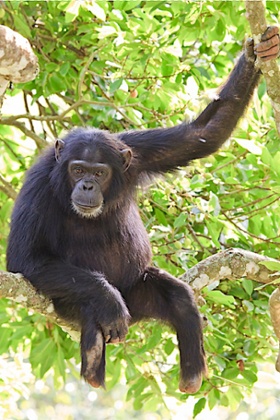
“Like landmines, snares do not discriminate, are virtually undetectable, and can cause irreversible permanent physical damage within a split second,” she explained. “Like landmines, snares are unforgiving death traps that cause pain, suffering, and mutilation. Like landmines, snares are detonated automatically by way of pressure from the animals stepping into or through it.”
It’s estimated that one third of Uganda’s chimps suffer from snare wounds like Max. And the chimps aren’t the only victims. While hunters usually set wire snares to catch the park’s antelopes (bushbucks and duikers) and bushpigs, they inadvertently injure and kill everything from elephants to leopards to African golden cats. In fact, snares are one of the largest – and least discriminatory – problems for wildlife in developing countries, but also one of the least publicised.
“Snares are the most insidious of hunting methods currently used in Africa,” said David Mills who is studying African golden cats in Kibale with the Wildlife Conservation Society-Uganda and cat conservation group, Panthera. “Coupled with the breakdown of hunting traditions and taboos and exploding populations of hunters, they have contributed to the collapse of wildlife populations in many parts of Africa.”
Snaring doesn’t only kill and maim individual animals, it can also impact a forest’s ecology. With fewer prey animals like duikers and bushpigs, wild cat populations may decline. And if vital seed disperser populations fall – such as chimps, elephants and forest antelopes – it could change the structure and richness of the forest.
“When a hunter sets a snare for a duiker, the snare is also set for a leopard or golden cat who may also be looking for that duiker,” said Mills.
At any one time, there are 15,000 active snares in Kibale National Park, according to researchers. That’s nearly twenty snares for every square kilometre. However, since 1997 a group of dedicated, specialised rangers have put their own lives on the line to fight back against this flood of snares.
Snare heroes
Their names are: Paul Mugisha, Charles Friday, Godi Nyesiga, John Tweheyo, and Amos Twinamasiko. Currently, these five Ugandans – and two other snare teams – are what stands between the mammals of Kibale and those unseen killer wires.
“Snare removal saves the lives of animals,” said Head Ranger Paul Mugisha. “Had it [not been for snare removal teams], there wouldn’t be any animals in the park.”
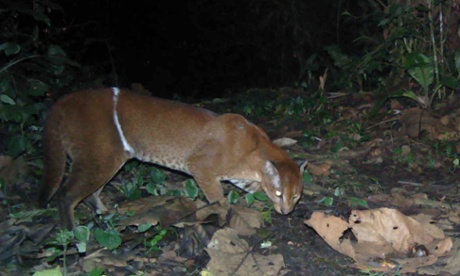
Junior Ranger, Charles Friday, also said that some populations of common snaring victims were “increasing” due to the team’s efforts. Anecdotally, researchers say they are seeing fewer snare-related injuries and deaths for the 1,400 eastern chimpanzees (Pan troglodytes schweinfurthii) in Kibale, which houses the largest population of chimpanzees in the country.
Other snare teams in the area include wildlife rangers with the Uganda Wildlife Authority (UWA) and a team with the Ngogo Chimpanzee Project.
Yet it remains difficult to really see if the problem is getting worse or better, according to Emily Otali, the Field Director of the Kibale Chimpanzee Project and co-director of the Kibale Snare Removal Programme. An expert on chimps, Otali is the first black African woman to earn a doctorate in primatology.
She said rangers continue to come home with more and more snares, but that might be due to the fact that there are more rangers now (the program began with just two) covering a larger area of the park, she added.
“So one could say there are more snares yet the number didn’t so much increase as our efforts to find them,” she said. “On the other hand...[Retired ranger John Okwilo] told me that for every 10 snares they remove in an area, the poachers will go back to that same area and set 100 new snares. For the poachers, it is a game of who will give up first!”
The Kibale Snare Removal Programme is a conservation initiative run by the Kibale Chimpanzee Project. The organisation is funded by several Jane Goodall Institute (JGI) branches in Europe – Austria, Switzerland and the Netherlands – and coordinates with the local JGI branch and the UWA, including the park’s wildlife rangers. But unlike wildlife rangers, the snare dispatchers move through the forest unarmed, making their job especially dangerous.
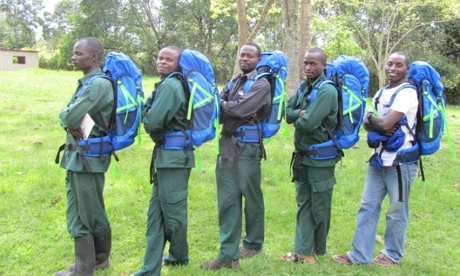
Photograph: Kibale Snare Removal Programme
“When there are many [poachers], we do hide from them and let them go,” said Okwilo, who retired earlier this year after 18 years on the team. He added that in such cases the team calls for armed wildlife rangers to track down poachers. If the poachers are few and unarmed, the snare squad will attempt arrest.
“In most cases, we are always afraid of [poachers], because some poach using guns while looking for big game like elephants,” Okwilo added.
But poachers aren’t the team’s only – or even highest – concern when in the forest.
“Despite challenges such as heavy rains, falling trees and armed poachers, elephants are always our biggest worry,” said Mugisha. The team has been chased and attacked by an elephant more than once during patrols.
Jessica Hartel, the programme’s head, said ranger safety is the “number one priority,” adding that “while some poachers are harmless locals setting the occasional snare in the forest, others are incredibly dangerous poaching much larger game like elephants and buffalo in teams armed with spears and guns. Our rangers are encouraged to patrol with [UWA armed rangers] and to never confront armed poachers without UWA.”
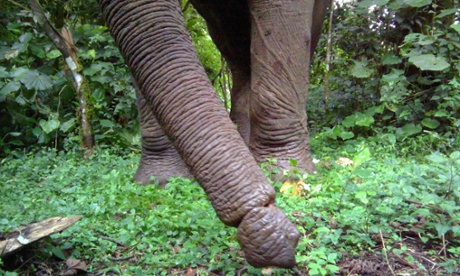
The team patrols daily, looking not only for snares, but also any other illegal activity in the park including firewood collecting, logging or grazing. They also spend eleven nights of every month camping deep in the forest, so they can cover remote areas.
“Since the inception of the Kibale Snare Removal Program in 1997, our rangers have removed over 6,500 snares,” said Hartel. “Despite our consistent efforts, snares continue to be a consistent, formidable threat.”
Socioeconomic realities
The team doesn’t only dismantle snares in the forest; it also works on changing hearts-and-minds in the park’s adjacent villages, which are booming. The total population surrounding Kibale has septupled in less than a century, and for many local villagers, snares provide the easiest way to access bushmeat inside the park.
Snares are “low cost with high potential benefit,” said Hartel, who added that hunters make the snares out of “recycled motorbike clutch or brake wire, which are cheap and readily available.”
“[Snares] are easy to set in the forest and do not require consistent monitoring,” she continued. “There is little time investment for local people living along the forest edge to enter and set a few nearby snares that can be checked once every few days.”
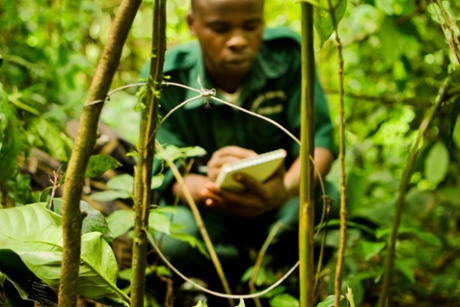
Although illegal, catching meat via snare is cheaper for many locals than rearing domestic animals or buying meat at the market.
“In a region where people live on $1 a month, not everyone can afford to buy meat at the butcher,” said Otali. However, she added that culture also played a role.
“Hunting in this area started as a sport for the king and his subjects. It is believed that the majority of the snares set are by people who still hunt for fun. Secondly, everyone concedes that bushmeat is tastier than domestic meat.”
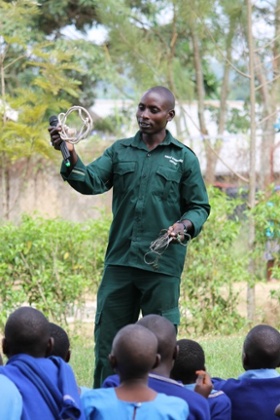
In order to combat snaring in the long-term, the organisation believes education and reaching out to the community is just as important as disarming these “landmines.”
“Snare removals act as a bandaid, providing a quick fix to the problem without providing long-term treatment. Educational outreach, on the other hand, is the medication that can provide real solutions that change behaviour,” said Hartel.
Partnering with the Kasiisi Project, the snare team routinely gives presentations to school-age children on the impacts of snaring and the importance of wildlife like chimpanzees and elephants in Kibale National Park.
“Many of these kids are children of hunters,” said David Mills withWCS and Panthera. “Encouraging these kids to care for the forest is critical to the long-term reduction of hunting. It doesn’t ultimately matter if they choose to hunt as adults or not. In the US, hunters can be great conservationists. They use their resource wisely because they want to keep using it. This can happen in Africa too.”
In addition to hunting, locals often enter the park to collect fuelwood or clear forest edges for crops. Kibale is a new park, only formally established in 1992, and has had a tenuous relationship with those living nearby.
Community views
The rangers, all of whom live in local communities, pointed out that local views towards the park were often complex and sometimes ambivalent.
“The local community have mixed feelings about conservation in Kibale. Few people understand and appreciate the work being done...and the majority have negative attitudes toward conservation and I think they are the ones responsible for all the illegal activities,” said Head Ranger, Paul Mugisha.
Some locals resent no longer being allowed to hunt or log inside Kibale, while others face conflict with elephants and baboons that raid their crops and gardens.
In order to offset some of these impacts, the government has set-up a revenue sharing programme whereby 20 percent of entrance fees to the park go back to local governments. However, this only comes to around $1 a year per family and some have complained of mismanagement of funds.
Moreover, Mugisha said this revenue “doesn’t directly contribute much to the people who have losses due to the animals.” He said that the UWA should change its approach to prioritise local people surrounding the park.
Still, Junior Ranger Godi Nyesiga said most people in the area “are lovers of conservation” and “feel touched when they hear that animals are dying because of snares.”
Nyesiga pointed out that the park plays a large economic role in the community beyond the revenue programme, providing jobs for wardens, rangers, field assistants and tourist guides.
“Others own hotels [and] lodges where tourists pay a lot of money,” he added.
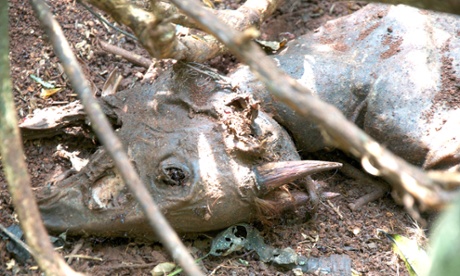
A study in 2011 found that residents near Kibale were actually better off economically than those who lived further away. A finding that might explain why people often choose to live at the edges of protected areas. Overall, the study also recorded data that showed economic conditions were improving, though deep poverty still remained in some places and wealth inequality was becoming a rising problem.
There is no quick fix to the issues between the wildlife and people of Kibale, but Hartel sees educaiton as one of the most important long-term solutions.
“Through conservation education we have observed positive shifts in students’ attitudes towards chimpanzees, elephants, and other wildlife accompanied by a growing interest in and passion for conservation,” she said.
Back to the chimps
Now meet Kaana: in 2000, a snare almost took Kaana’s hand. She disappeared from her chimp family eight year after being snared and conservationists feared the worst. However, a few months later she showed up in another chimp community 10 kilometres away. Despite her injury, Kaana has become a mother.
“Chimps are very resilient, they survive easily with missing limbs and after bad injuries. They crawl or drag themselves on the ground and on trees and live,” said chimp expert, Otali, who noted that Kaana’s story was one of the happy ones. “But this is not necessarily easy or the life they should live.”
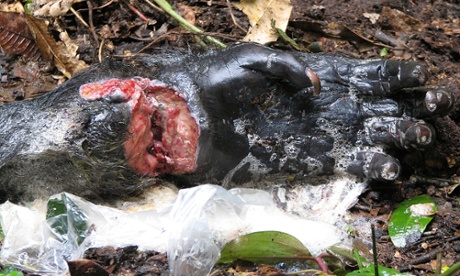
While some chimps survive, others don’t. And the toll can ripple through the chimp community.
“Nectar first lost her left hand at age five and was then again snared on her right hand at age eight,” said Hartel. “Unable to walk or feed, Nectar’s health began to deteriorate. Nectar then lost her mother and was left to care for her two-year-old brother, Pollen. Within a few months, both Pollen and Nectar disappeared and were never seen again.”
In the end, snaring can prove as deadly to chimps – or elephants, or leopards, or any other large mammal in the forest – as the blast of a gun. And, it should be remembered that there are far more snares in Kibale National Park than guns. The same could likely be said for many forests across Africa and Asia.
“We need more rangers out there removing snares,” said Otali.
Just as snares are hidden away in foliage, bushes and leaflitters, so the problem continues to remain opaque – and sometimes even ignored – compared with the more dramatic ways of wiping out the world’s wildlife. But in some places and for some species, snares are undoubtedly among the biggest threats. Just ask Max.
